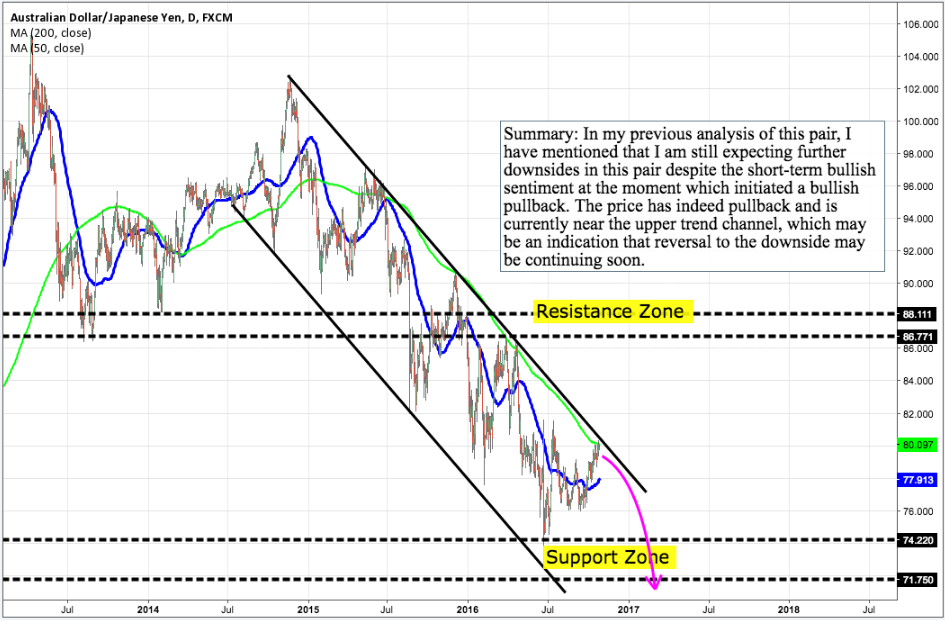Fundamental Outlook: AUD/JPY
The main event during the Asia-Pacific session was Japanese inflation data. National CPI and National Core CPI remained unchanged at -0.5% with Tokyo CPI slightly beating expectations at 0.1% for the headline and -0.4% for the core versus expectations of -0.5% for both data points. The BoJ's own measure of core inflation continues to decline to fresh lows of 0.2% versus expectations of 0.3%. Overall the data failed to provide any market-moving surprises with most JPY pairs remaining relatively unchanged following the release. There is no tier 1 data due to be released in today's London session. In today’s session, we expect the strongest currency to be AUD as recent strength in the commodities complex has seen AUD remain relatively well supported.
Source: Jarratt Davis
Technical Outlook: AUD/JPY

Overview of Currencies
USD: The Federal Reserve are most likely to leave their current policy unchanged at their next meeting due to its proximity to the US elections and the fact that the Fed's November meeting has no scheduled press conference which would be necessary for the Fed to provide further in-depth information following such a decision. Given 14 of 17 Fed members expect at least a hike in 2016, there is a strong possibility of the Fed increasing rates by 25 basis points at their December meeting. This gives the USD currency an overall bullish tone for the next three months.
EUR: The ECB are most likely to leave their policy unchanged at their next meeting because they have already cut their main rates heavily over recent years and they are at what many experts consider to be an ultimate low. If the bank did conduct a policy change within the next three months, then the most likely move is an increase in its QE programme because it is still battling low inflation alongside low interest rates, so more powerful action could be needed. This gives the EUR currency an overall bearish bias over the next three months.
GBP: The BoE are most likely to ease policy within the next three months with the BoE's November meeting seen as the most likely meeting for further cuts providing "their August forecasts are met". The UK economy, however, has been much more resilient following the 'Brexit' than many had expected, and therefore should UK data continue to surprise, expectations for further BoE easing may be pushed further back and shift expectations towards the BoE remaining on hold. Overall however given the BoE's latest comments and expectations for further cuts potentially as soon as November, we maintain our bearish fundamental bias on GBP.
AUD: The RBA are most likely to leave policy unchanged at their next meeting, however, until we start to see any notable pickup in inflation, further easing remains a distinct possibility. Continued AUD appreciation is also noted as a concern for the RBA and likely provides an additional argument for further cuts. Nevertheless, following Q3 CPI, futures markets are pricing in less than a 10% chance of a 25 basis point cut, suggesting the RBA will remain on hold. For these reasons we currently hold a weak bearish bias for AUD.
NZD: There is a strong possibility that the RBNZ could ease policy further at their November meeting due to continued concerns over inflation. Despite Q3 inflation beating expectations at 0.2% q/q and y/y, the RBNZ are still expected to ease at their November meeting with OIS pricing suggesting an 84% chance of a 25 basis point cut. With continued expectations for further RBNZ easing, we maintain a bearish bias on NZD.
CAD: The BoC are most likely to leave monetary policy unchanged at their next meeting as Canadian inflation is within the BoC’s target range of 1-3% with the economy also supported by accommodative fiscal measures. If the BoC did conduct a policy change within the next three months, it would likely be a rate cut based on concerns over Canada’s competitiveness since CAD’s appreciation throughout the year and increasing concerns over inflation. Although this gives CAD a slightly bearish fundamental bias, with most central banks currently in easing cycles CAD has a comparatively neutral bias.
JPY: The BoJ will most likely need to ease policy further as the increases made to its ETF purchases and USD lending programmes will probably be insufficient in helping inflation reach its target of 2%. Kuroda’s latest comments that " there is currently no need to reduce rates" would, however, suggest that the BoJ are likely on hold for the foreseeable. Therefore we continue to hold our overall bearish fundamental bias, however, acknowledge that further declines in inflation may be necessary before further easing can be expected.
CHF: The SNB are most likely to leave their policy unchanged at their next meeting, as interest rates in Switzerland already remain at a record low of -0.75%. If the SNB were to change policy in the next three months, it would likely be a rate cut as inflation continues to remain far below the SNB’s target. This gives CHF an overall bearish tone.
Source: Jarratt Davis